What’s in Trump’s Executive Order on the Defense Production Act?
President Trump’s new executive order provides additional authorities to address medical supply shortfalls in combating COVID-19—but it doesn’t utilize any of them.

Published by The Lawfare Institute
in Cooperation With

On March 18, President Trump issued an executive order invoking the Defense Production Act (DPA) to prioritize the production of much-needed medical equipment and supplies to combat the novel coronavirus. This follows a March 13 letter signed by 57 House Democrats requesting the president to invoke the 1950 act to “begin mass production of supplies needed to address the ongoing Coronavirus Disease 2019 (COVID-19) pandemic.”
As the Centers for Disease Control and Prevention (CDC) notes, with the decrease in exports from countries affected by the virus and an increase in demand from medical professionals, certain manufacturers of personal protective equipment (PPE)—such as masks, eye protection and isolation gowns—have found satisfying the increased volume of orders challenging. In light of the public health challenges, the DPA has taken on a renewed significance. Recently, the Congressional Research Service published a report detailing policy considerations in employing the act in the face of the current pandemic.
However, the new executive order does not so much directly invoke the DPA as it creates the conditions under which the administration can later employ its authorities. Essentially, it classifies health and medical resources needed to respond to the spread of COVID-19 in a way that authorizes the administration to later have private businesses prioritize government contracts over other contracts. The order also delegates broad authority to the secretary of health and human services (HHS) to later employ certain powers of the DPA.
Before diving into the particulars of the executive order, it’s useful to review the DPA to provide some context for the authorities the administration is now choosing to exercise.
What Is the Defense Production Act?
Originally passed in 1950, the DPA was part of a response to the Truman administration’s desire to have stronger executive authority in the burgeoning Cold War as well as the hot conflict on the Korean Peninsula. Echoing powers from World War II that have since lapsed, the DPA gave the president broad authorities over national economic policy—including the ability to expand production capacity of certain materials and services as well as to prioritize defense production.
Since the passage of the DPA, Congress has reauthorized some version of the law more than 50 times. Its latest reauthorization came in August 2018 and lasts until September 2025. Only three titles survive from the initial act.
Title I: Priorities and Allocations
This title contains two significant subsections that have relevance for Trump’s executive order, falling under Section 101:
(a) Allocation of Materials, Services, and Facilities
The President is authorized (1) to require that performance under contracts or orders (other than contracts of employment) which he deems necessary or appropriate to promote the national defense shall take priority over performance under any other contract or order, and, for the purpose of assuring such priority, to require acceptance and performance of such contracts or orders in preference to other contracts or orders by any person he finds to be capable of their performance, and (2) to allocate materials, services, and facilities in such manner, upon such conditions, and to such extent as he shall deem necessary or appropriate to promote the national defense.
(b) Critical and Strategic Materials
The powers granted in this section shall not be used to control the general distribution of any material in the civilian market unless the President finds (1) that such material is a scarce and critical material essential to the national defense, and (2) that the requirements of the national defense for such material cannot otherwise be met without creating a significant dislocation of the normal distribution of such material in the civilian market to such a degree as to create appreciable hardship.
Essentially, the president has the authority to prioritize any contracts other than employment contracts to ensure the federal government receives services and materials before other competing interests, so long as doing so is in the interest of the national defense. In other words, under this section a manufacturer must service the government contract over others.
This power also extends to the allocation of services and materials “necessary or appropriate to promote the national defense.” However, the control over the distribution of these materials depends on whether they are “critical” and “strategic” as defined in Section 101(b). It is important to note that no president has taken an allocation action since the end of the Cold War.
Title III: Expansion of Productive Capacity and Supply
This title contains multiple authorities by which the president can ensure the United States has the capacity to produce critical technological items and other materials needed for the national defense. Many of these authorities deal primarily with financial incentives for manufacturers, ranging from loan guarantees to purchase commitments. The Department of Defense frequently employs this title. In fiscal 2017, the department managed a portfolio under Title III worth more than $1 billion in combined government and industry investment.
The recent executive order does not reference this title. However, the Congressional Research Service notes that “[u]nder Title III, the federal government could use authorized incentives to expand domestic capacity for PPE manufacturing to meet the needs of the emergency.” The administration could conceivably employ this authority in the future.
Title VII: General Provisions
This title contains various clarifying provisions as well as additional authorities. Of note is the definition of “national defense”:
The term “national defense” means programs for military and energy production or construction, military or critical infrastructure assistance to any foreign nation, homeland security, stockpiling, space, and any directly related activity. Such term includes emergency preparedness activities conducted pursuant to title VI of The Robert T. Stafford Disaster Relief and Emergency Assistance Act [42 U.S.C. § 5195 et seq.] and critical infrastructure protection and restoration.
Since its initial adoption, Congress expanded the definition from one based on military necessity to its current formulation above. Today, national defense encompasses not only the military but also homeland security, domestic preparedness and other national emergencies—which could include pandemics.
Additionally, Section 708(c)(1) of this title gives the president the authority to approve “voluntary agreements” among competing private industry interests:
Upon finding that conditions exist which may pose a direct threat to the national defense or its preparedness programs, the President may consult with representatives of industry, business, financing, agriculture, labor, and other interests in order to provide for the making by such persons, with the approval of the President, of voluntary agreements and plans of action to help provide for the national defense.
In short, the president could approve agreements among competing businesses that would otherwise run afoul of antitrust or contract law. However, the process is not as simple as the president signing off on an agreement, and businesses are not exempt from all liability. Section 708 outlines additional responsibilities between federal department heads and private industry. For example, the attorney general and the chairman of the Federal Trade Commission must monitor the agreement to ensure that anti-competitive practices are being prevented, that the agreement is carrying out the purposes of Section 708(c)(1) and that the parties are following the terms of the agreement.
Title VII also covers rulemaking under the DPA, sunset provisions of the act and the establishment of the Committee on Foreign Investment in the United States (CFIUS).
What’s in the Executive Order?
This is not the first time that Trump has invoked the DPA. In the summer of 2019, he determined that “the domestic production capability for Rare Earth Metals and Alloys is essential to the national defense.” That order flew relatively under the radar, however; the last executive order invoking the DPA to receive much notice was from President Obama, who delegated several authorities from the DPA to his Cabinet secretaries in Executive Order 13603. However, these authorities were geared primarily toward assessments and preparedness in anticipation of a national emergency. Trump’s executive order calls for more concrete action in the midst of a crisis—though it does not actually mandate that any action be taken.
The order is relatively short. It specifies that PPE and ventilators meet the criteria specified in Section 101(b) of the DPA—authorizing the federal government to make prioritization and allocation decisions for PPE and ventilators. It also delegates to the HHS secretary the authority to identify additional health and medical resources that fall under Section 101(b). The secretary, then, need not wait for another executive order to prioritize or allocate other materials and services.
Next, the order delegates broad DPA authorities to the HHS secretary with respect to “all health and medical resources needed to respond to the spread of COVID-19 within the United States.” These authorities include the prioritization of contracts and orders; allocation of materials, services, and facilities deemed necessary; and the implementation of Title VII of the DPA (subchapter III of 50 U.S.C. Chapter 55). This would ostensibly permit the secretary to approve voluntary agreements among private industry as long as the rest of the requirements of Section 708 are met. For example, as the Congressional Research Service report suggests, a voluntary agreement could be used to coordinate the production of PPE among several businesses even though such coordination would normally run afoul of antitrust statutes.
The order also authorizes the HHS secretary under Section 101 of the DPA, in consultation with the secretary of commerce and other department heads, to determine the nationwide priorities and allocation of all health and medical resources, including their distribution in the civilian market, for responding to COVID-19. Since this power has not been used for some time, it is difficult to predict how exactly the government will employ it to combat the current pandemic. However, it does appear that the HHS secretary could start making decisions on the allocation of medical resources within the civilian market, such as PPE and ventilators, across the country to meet competing needs.
The order also calls on the HHS secretary to issue such “orders and adopt and revise appropriate rules and regulations as may be necessary to implement this order.”
While these delegated authorities are broad and far reaching, it is hard to say specifically how the HHS secretary will employ his new powers in tackling the current pandemic. Currently, the executive order does not mandate any concrete steps but, rather, gives the secretary various authorities to prioritize and allocate medical materials and services to respond to the COVID-19 pandemic. The machinery for combating the pandemic under the DPA is now in place. The question is when the administration will put that machinery to work.





